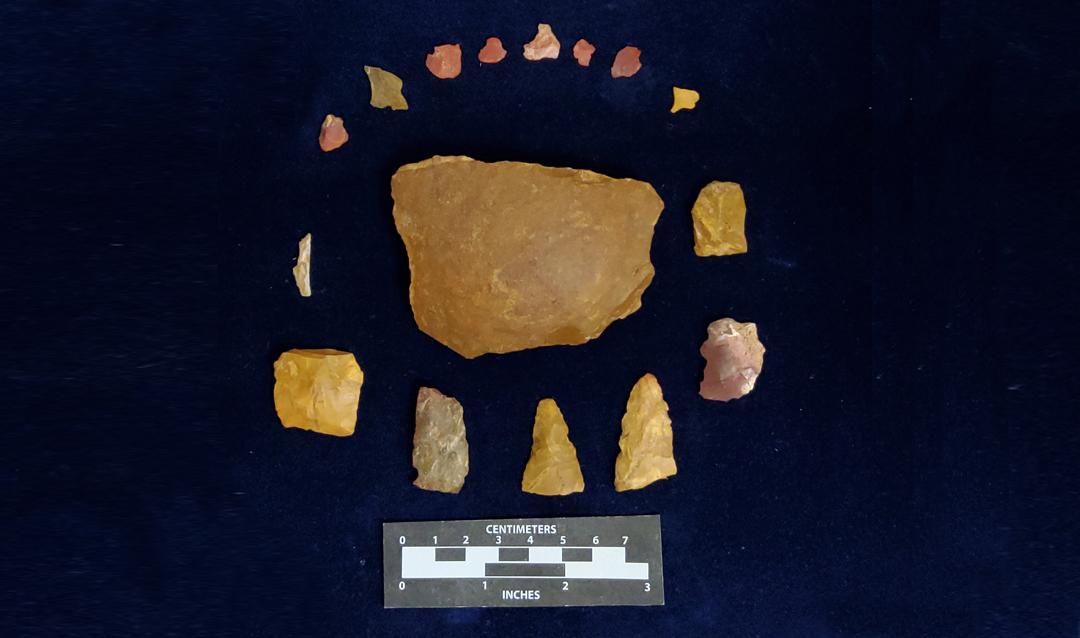More than 90 Native American artifacts—including pieces of pottery, tools and a flint knifepoint believed to be about 3,000 years old—have been found on property owned by Lehigh in Upper Saucon Township. The artifacts will be returned to Delaware Nation, a sovereign, federally recognized nation of Lenape people whose traditional homelands encompass the Lehigh Valley, including what is today Lehigh’s campus.
The artifacts, which include complete tools made of jasper, quartz and chalcedony, were found during a Pennsylvania Department of Transportation (PennDOT) archeological survey of nearly 100 acres, about half of which is owned by Lehigh. Once the artifacts are returned Delaware Nation plans to display them in their new museum expected to open this spring at their headquarters in Anadarko, Oklahoma. The museum will be housed in a historic building that includes Delaware Nation’s library, archive, and historic preservation office, said Carissa Speck, tribal historic preservation director for Delaware Nation.
The vast majority of Lenape artifact collections are still housed across Lenape homelands, which encompass eastern Pennsylvania, New Jersey, Delaware, and parts of New York, Connecticut and Maryland. Delaware Nation and the other federally recognized Lenape Tribal Nations were forced out of their homelands as a result of settler colonial dispossessions and broken treaties. Other federally recognized Lenape Tribal Nations are: Delaware Tribe of Indians (Bartlesville Oklahoma); the Stockbridge Munsee Community (Bowler Wisconsin), and the Munsee Delaware Nation and the Eelūnaapèewii Lahkèewiit (Delaware Nation at Moraviantown), both in Ontario, Canada.
Since looting of Native artifacts is still a problem in many areas, Delaware Nation does not want to share specifics of where the artifacts were found, Speck said.
“These artifacts will help us grow our collection, and we will be able to display them for our tribal citizens to have access to and see them in person,” she said. “Most tribal citizens do live in Oklahoma. If the artifacts were on display in Pennsylvania, many of our members wouldn’t be able to see them.”
In the fall of 2023, Lehigh officials received a letter from A.D. Marble, an engineering firm hired by PennDOT for the archeological survey, that stated the artifacts had been found, said Erin Kintzer, senior director of real estate services for Lehigh.
Laws vary depending on the state, but in Pennsylvania, artifacts found on private property belong to the current property owner, said Steven McDougal, an archeologist for PennDOT’s District 5, based out of Allentown.
“Typically very few collections have gone to Native American tribes or nations," he said. “Having collections donated to Native American tribes and nations is a relatively new idea, at least in Pennsylvania. I personally think it’s a really good idea.”
Most of the time, the landowner will keep what is found. If not, PennDOT encourages the landowner to donate the collection to The State Museum of Pennsylvania in Harrisburg, McDougal said.
Kintzer said it was the first time in her nearly nine years at Lehigh that she was contacted about artifacts. Kintzer consulted two sociology and anthropology professors and spoke with Lehigh College of Health Dean Beth Dolan to decide the best option for the artifacts.





